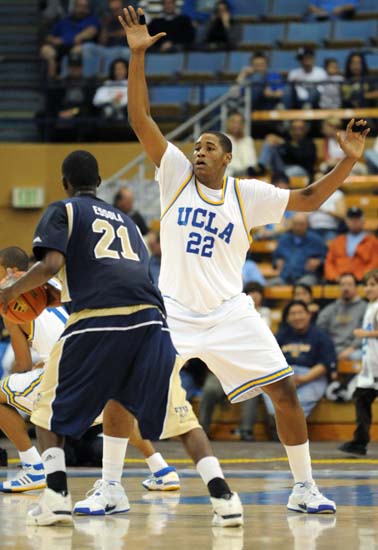
When J’mison Morgan arrived at UCLA last fall, many expected the 6-foot-10 center to make an impact on the Bruin basketball team even as a freshman. UCLA had lost nearly 64 percent of their rebounding from a year before and they needed as many big men to step up as possible.
But after just a few minutes on the fast-paced court of Division I college basketball, it appeared the expectations for Morgan had run out of steam.
Weighing 255 pounds at the start of last season, Morgan was unable to contribute consistently, getting winded every time the team went up and down the court. He played just 5.4 minutes per game of mostly garbage time in 21 of the Bruins’ 35 contests.
As the nation’s No. 3 center according to Scout.com coming out of high school, Morgan made a plan when the school year was over. He would do whatever it took to make sure his physical condition would not hold him back from playing to his full potential.
“Basically, the whole coaching staff was like, “˜if you want to play here, you’re going to need to get fit,'” Morgan said. “So, me and Wes (Long), our strength coach, did a lot of stuff over the summer.”
Seeing him today, it’s clear Morgan did look different. With his upper body looking much leaner and more toned, Morgan has gotten his weight down to 240 pounds and reduced his body fat percentage from 17 percent to just seven.
“I’m jealous,” coach Ben Howland said. “Seven percent? That’s pretty good.”
Long, the team’s strength and conditioning coach, was assigned to facilitate the physical change that everyone ““ Morgan most of all ““ wanted to see.
Although athletes’ offseason workouts are officially optional, Morgan spent much of the summer in the basement weight room of UCLA’s Acosta Athletic Complex, working with Long.
For 12 straight weeks, they worked on his conditioning five days a week.
Three of those days, Morgan would run on a special treadmill that forced him to move the ground below his feet instead of the other way around. Running for just 10-20 minute spans, he focused on pushing himself as hard as he could.
The other two days were reserved for stamina. Morgan used the stationary bike for 45-minute stretches to lean up and increase his aerobic capacity.
As for any body transformation, a change in diet was, of course, a big influence.
“I kind of stopped eating fried foods and cut dessert for awhile,” Morgan said. “Like period. No more Puzzles, no Diddy Riese, none of that.”
UCLA Athletics also employs a nutritionist to talk to athletes about healthy diet habits, but Long lamented it was the one thing the coaches had little control over.
“He did improve on his diet and obviously that helped because he wouldn’t have changed if it didn’t improve,” Long said. “But like most young kids it’s still something he needs to work on. We don’t have that 24-hour surveillance on them to see exactly what they’re putting in their bodies.”
UCLA athletes, undoubtedly, have a high standard of physical fitness to live up to and sometimes even the most highly touted recruits have the most work to do.
“It’s a struggle for anybody when you come in and you were the superstar on your high school team,” Howland said. “You’re starting over again.”
For Morgan, the work is far from over if he wants to keep his body in top shape.
“It’ll always be in-progress for him,” Long said. “He’s going to have a tough time just taking a few days off. He’s always going to have to be doing something. It’s just his body type.”
